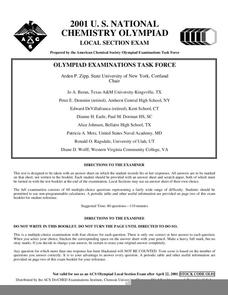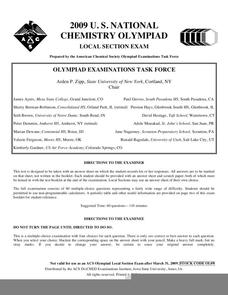Curated OER
Rechargeable Batteries
Students explore how rechargeable batteries work by conducting a series of experiments. In this physics lesson plan, students discuss the benefits of using rechargeable batteries over disposable ones. They build their own battery charger...
Virginia Department of Education
Metals, Nonmetals, and Metalloids
How can one easily classify metals, nonmetals, and metalloids? Pupils answer this question as they experiment with unknown substances and perform tests on conductivity, brittleness, and malleability to determine...
Columbus City Schools
Force Field Physics
Attracted class members to an activity-packed journey through the science behind the invisible forces at work all around us. From jump rope generators to junkyard wars, there's never a dull moment when eighth grade physics scholars...
Curated OER
Electrical Resistivity
Students examine how materials oppose the flow of an electrical current. In this resistivity lesson students complete several experiments on the differences between resistance and resistivity.
Curated OER
Conductivity Lessons
"Conduct" some simple experiments with these great lesson plans on conductors and insulators!
Curated OER
Physical Science: Magnetism and Electricity
Young scholars use a variety of objects to test for ability to "stick" to a magnet. They perform an experiment to see that electricity in circuits can produce light, heat, sound, and magnetic effects. They discover magnets attract and...
Curated OER
Lemon Battery
Students construct their own battery made of lemons. In this electrochemistry lesson, students explain why lemons conduct electricity. They perform a series of experiments to investigate its conductivity.
Curated OER
Static Electricity 1: Introducing Atoms
Learners explore webpages to research the nature of atoms, including electrons, protons, and neutrons. This lesson plan is the first of a four-part series on static electricity. They see that static electricity involves + and - charges.
Curated OER
Keeping Warm: Science Review Game
Test the class on what they know about thermal conduction, insulation, and heat. This interactive game provides 15 questions related to the science of temperature, heat, and cold. Keep your class warm with a fun review game!
Curated OER
Types of Bonding Lab
Chemistry lab learners experiment to identify a series of unknown compounds. They choose which tests to perform, but you may suggest melting or boiling point, solubility, electrical conductivity, and malleability. This is a terrific...
US Department of Energy
Geothermal Energy
With Earth Day quickly approaching, as well as many science fairs, why not challenge your class to investigate geothermal energy or other renewable energy resources? There are five driving questions explored in depth here, as well as...
Curated OER
2001 U.S. National Chemistry Olympiad - Local Section Exam
Sixty multiple-choice chemistry questions make up this comprehensive exam used for the 2001 US National Chemistry Olympiad. Every topic that you would expect to approach in a general chemistry class is queried on. You could easily use...
Curated OER
2009 U. S. National Chemistry Olympiad - Local Section Exam
Here is a copy of a past national challenge exam that you can use in your general chemistry course as a unit or semester review. Sixty multiple-choice questions query learners on properties of matter, stoichiometry, reactions, and...
Curated OER
Electric Light Tower
Students examine the San Jose Light Tower as an example of the development of urban lighting circa 1900. They view a slideshow, conduct research and write newspapers to chronicle the lighting ceremony from a variety of perspectives.
Curated OER
Electrical Noise and Interference
For this electronics worksheet, students identify and differentiate the different types of noise. They complete 4 short answer questions about the topic.
Curated OER
Click, Clack, Moo: Electric Blanket Science
Students read Click, Clack, Moo: Cows That Type by Doreen Cronin and discuss the similarities and differences between electric blankets and regular blankets. They brainstorm a list of reasons why the farm animals wanted electric blankets.
Curated OER
Electric Circuits
Students explore energy by completing an electricity worksheet. In this conductors lesson, students define the energy related vocabulary terms circuit, electronics, conductor and semi-conductor before examining computer chips in class....
Curated OER
Plate, punch card, and instructions for Herman Hollerith's Electric Sorting and Tabulating Machine
Students read an article and participate in a class discussion. In this technology and engineering instructional activity students conduct an online search for images and terms.
Curated OER
Let's Light up a Light Bulb
Third graders investigate electricity. For this electricity lesson, 3rd graders observe a familiar battery-operated toy and brainstorm reasons why and how the battery works. Students work in pairs to explore batteries, bulbs,...
Curated OER
Go with the Flow
Students gain an understanding of the difference between electrical conductors and insulators, and experience recognizing a conductor by its material properties. They build a conductivity tester to determine whether different objects are...
Curated OER
Conductors and Insulators
In this conductors and insulators worksheet, learners answer 11 questions about electrical resistance, conductance, gauge scale, and breakdown voltage.
Curated OER
Acids and Bases: Their Reactions, Conductivity, Base Indicators and Neutralization Reaction
Students conduct experiments and collect data to determine physical and chemical characteristics of acids and bases.
Curated OER
Liquid Conductors
Students identify liquids as conductors. In this circuits lesson, students build a circuit, then use various liquids to complete the circuit, and determine which liquids successfully conduct electricity.
Curated OER
Applied Science - Physics Lab
Students investigate electricity. In this Physics lesson, students experiment with insulators and conductors of electricity. Students use batteries as the energy source for the experiment.

























